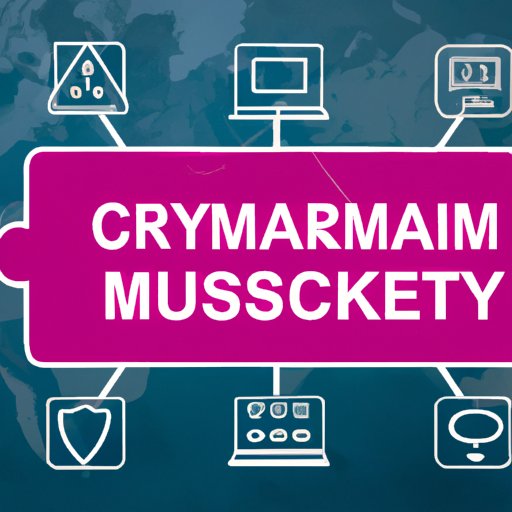Introduction
Cyber supply chain risk management (CSCRM) is a process used by organizations to identify, assess, and mitigate risks associated with their supply chain. The goal of CSCRM is to ensure that the products and services provided by suppliers are secure, compliant, and do not introduce any new security risks into an organization’s environment. By implementing CSCRM, organizations can reduce their exposure to cyber threats, increase their security posture, and protect their data and systems from malicious actors.

Exploring the Basics of Cyber Supply Chain Risk Management
In order to understand how CSCRM works, it is important to first understand the different types of cyber risks that organizations face. Cyber risks can be broadly categorized into two main types: internal risks and external risks. Internal risks are those that originate within the organization, such as employee negligence or errors, while external risks come from outside sources, such as hackers or malware.
Organizations must also be aware of the potential impacts of cyber risks on their business. These impacts can range from financial losses to reputational damage. It is important for organizations to be able to identify and assess these risks in order to properly manage them. To do this, organizations need to have a comprehensive understanding of their supply chain and the potential risks associated with it.
Once an organization has identified the cyber risks associated with its supply chain, it can begin to develop strategies for mitigating those risks. This can include implementing technical measures such as vulnerability scanning and patching, as well as administrative controls such as supplier contracts and third-party audits. Additionally, organizations should strive to stay up-to-date on the latest cyber threats and trends so they can quickly respond to any emerging risks.
Using Technology to Combat Cyber Supply Chain Risks
Technology plays an important role in CSCRM. Organizations can use a variety of technologies to help them identify and monitor potential cyber risks in their supply chain. These technologies include automated tools such as network scanners, intrusion detection systems, and security information and event management platforms. Additionally, organizations can leverage artificial intelligence and machine learning to detect anomalies and threats in real time.
The use of technology can also help organizations better understand the potential impact of cyber risks on their business. For example, organizations can use analytics tools to analyze data from their supply chain and gain insights into the potential risks associated with their suppliers. This can help organizations make more informed decisions about which suppliers to work with and how best to mitigate the risks associated with them.
An Overview of Cyber Supply Chain Risk Management Strategies
When implementing CSCRM, organizations should strive to create a comprehensive strategy that includes both technical and administrative measures. This strategy should include elements such as establishing supplier requirements, conducting regular assessments of suppliers, and developing incident response plans. Additionally, organizations should strive to create a culture of security within their organization and ensure that all employees are aware of their roles and responsibilities when it comes to preventing and responding to cyber threats.
Organizations should also consider utilizing third-party vendors or services to help them manage their CSCRM efforts. These vendors can provide specialized expertise and resources that can help organizations create and implement effective CSCRM strategies. Additionally, third-party vendors can help organizations stay up-to-date on the latest security threats and regulations, as well as provide support in the event of a breach.

Analyzing the Impact of Cyber Supply Chain Risk on Businesses
It is important for organizations to understand the potential impact of cyber supply chain risk on their business. Cyber attacks can lead to significant financial losses, as well as reputational damage. Additionally, organizations may face regulatory penalties if they fail to comply with applicable laws and regulations. As such, it is important for organizations to assess and measure the potential impact of cyber threats on their operations.
Organizations can use a variety of methods to assess and measure the impact of cyber supply chain risk on their business. These methods include using analytics tools to identify patterns and trends in their data, conducting surveys and interviews with stakeholders, and evaluating regulatory compliance. Additionally, organizations can leverage industry frameworks such as NIST 800-161 to assess their supply chain risk.
Understanding the Benefits of Implementing Cyber Supply Chain Risk Management Solutions
Implementing CSCRM solutions can help organizations reduce their exposure to cyber threats and improve their overall security posture. By leveraging the latest technologies, organizations can gain greater visibility into their supply chain and identify potential risks before they become a problem. Additionally, organizations can use CSCRM solutions to automate certain processes, such as vulnerability scanning and patching, which can help reduce the amount of manual labor involved in managing cyber threats.
Organizations can also benefit from CSCRM solutions by improving their compliance posture. By using CSCRM solutions to monitor their supply chain, organizations can ensure that they remain compliant with applicable laws and regulations. Additionally, organizations can use CSCRM solutions to streamline their audit processes and ensure that they are prepared for any external audits.

Examining the Steps Needed to Create an Effective Cyber Supply Chain Risk Management Plan
Creating an effective CSCRM plan requires organizations to take a number of steps. First, organizations should conduct a thorough assessment of their supply chain to identify potential risks. Next, organizations should develop a comprehensive strategy for mitigating those risks. This strategy should include both technical and administrative measures, such as supplier contracts, third-party audits, and incident response plans. Additionally, organizations should strive to educate their employees about their roles and responsibilities when it comes to preventing and responding to cyber threats. Finally, organizations should regularly monitor their supply chain to ensure that their CSCRM efforts are effective.
Creating an effective CSCRM plan can be challenging. Organizations must be aware of the potential risks associated with their suppliers and be willing to invest resources into developing and implementing an effective strategy. Additionally, organizations must stay up-to-date on the latest cyber threats and regulations, as well as be prepared to respond quickly in the event of a breach.
Conclusion
Cyber supply chain risk management is an important process for organizations to understand and implement. By leveraging the right technologies and strategies, organizations can reduce their exposure to cyber threats and ensure the security and compliance of their supply chain. Additionally, organizations should strive to create a culture of security within their organization and ensure that their employees are aware of their roles and responsibilities when it comes to preventing and responding to cyber threats.
(Note: Is this article not meeting your expectations? Do you have knowledge or insights to share? Unlock new opportunities and expand your reach by joining our authors team. Click Registration to join us and share your expertise with our readers.)
